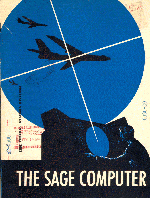The SAGE program significantly advanced the state of the art in human-computer interaction, influenced the thinking of J.C.R. Licklider, caused the establishment of the MIT Lincoln Laboratory where Lawrence Roberts later worked, and established one of the first wide-area networks.
Thanks in part to Vannevar Bush’s funding, the Massachusetts Institute of Technology (MIT) became a hotbed of advanced research. One of their most influential projects was the Semi-Automatic Ground Environment (SAGE) program, established in 1954 by the US Air Force to develop a continental air defense system to protect against a nuclear bomber attack from the Soviet Union.
MIT established the Lincoln Laboratory in Lexington, Massachusetts, to produce the SAGE system design. Lincoln Labs went on to do a great deal of useful later research, and gave their best network scientist, Lawrence Roberts, to the IPTO to help create the ARPANET. In 1958, the MITRE Corporation was formed from the Computer System Division of the Massachusetts Institute of Technology Lincoln Laboratories, and conducted the software development of SAGE’s digital computer system. The System Development Corporation in Santa Monica was created to develop the software. The program drove the discovery of several seminal software engineering concepts, such as multi-user interaction, advanced data structures, structured program modules, and global data definitions.
MIT and IBM developed the IBM AN/FSQ-7 computer to run the SAGE centers. The final model was the largest computer ever built, and weighed 250 tons, took up twenty thousand square feet of space, and was delivered in eighteen large vans. It had 50,000 vacuum tubes, more than 150 CRT monitors, needed more than a million watts of power, and took up two stories of a building. The vacuum tubes generated so much heat that human beings couldn’t stand close to the computer for more than a few seconds, and the whole computer would melt and self-destruct within sixty seconds if the air conditioning ever failed. The US Air Force bought twenty-seven.
Operators accessed the SAGE system through the first “cathode ray displays” or monitors, and used a light pen to select tracks of potential incoming hostile aircraft and manage their status. When SAGE was deployed in 1963, it consisted of 24 Direction Centers and 3 Combat Centers, each linked by long-distance telephone lines to more than 100 radar defense sites across the country, thereby establishing one of the first large-scale wide-area computer networks. This had a great influence on a lot of people who worked on the program, including Licklider, who later became the first Director of the IPTO and initiated the research that led to creation of the ARPANET. SAGE remained in continuous operation until 1983.
Resources. The following sites provide more information on SAGE:
- Fact sheet — SAGE computer backup, the Burroughs Corporation AN/GSA-51 Radar Course Directing Group for the Back Up Interceptor Control System (BUIC)
